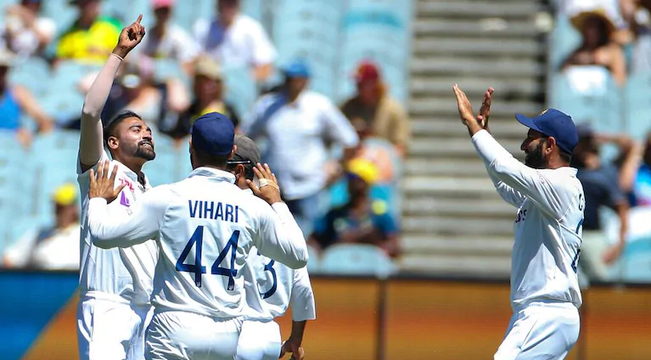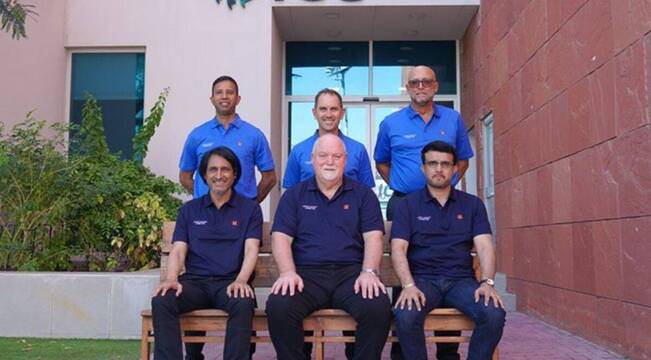New Delhi, November 03, 2023 : Afghanistan captain Hashmatullah Shahidi, assistant coach Raees Ahmadzai and former coach Lalchand Rajput say that besides international coaches and stints in top franchise leagues, investment in domestic cricket in the past ten years has helped Afghan cricketers
“Ye aaj subah hi gira hai (This has fallen down in the morning)’, Mirwais Ashraf pointed his finger towards an American chopper, a Sikorsky, lying on the ground where Afghanistan cricket used to train,” Rashid Latif, the former Pakistan captain and wicketkeeper recalls to The Indian Express.
You can try your hand at solving our Cricket World Cup crossword
Latif was appointed as the first head coach of Afghan cricket in 2010. Mirwais Ashraf is now the chairman of the country’s cricket board, and as per Latif, he is working tirelessly to develop the cricketing infrastructure in the country.
“Mirwais made his debut under me. We are still in touch, he is driven to make cricket popular in Afghanistan. The first generation, who I coached, grew up in a refugee camp in Peshawar after Russia’s invasion. The current lot are the victims of the Taliban war. The passion and the team spirit was always there. It was the same a decade ago as well,” recollects Latif.
The Afghan team has already defeated three World Cup winners — England, Pakistan and Sri Lanka so far. It is a mix of home-grown cricketers steeped in nascent but committed domestic cricket, T20 stars who play in franchise leagues around the world and canny coaching personnel who’ve planned precisely for this World Cup that has brought them within one more miracle win from a semifinal spot. Afghanistan cricket has come a long way since that morning when a chopper thudded onto one of its grounds, casting relentless shadows of war.
Investment in infrastructure
Mohammad Khan Zadran, who has played a pivotal role in the rise of Rahmanullah Gurbaz, Ibrahim Zadran and Mujeeb ur Rahman, says the growth of domestic infrastructure has helped this team grow.
“There are almost 5,000 clubs from 34 provinces. In Khost only there are 110 teams. Club cricket goes on from June to September-October. Then selection happens for Grade 2, which takes place from January to February. Then Grade 1 in March and April, it is first-class cricket. The 50 overs and T20 league take place in June and July. Grade 3 is all about school cricket,” says Zadran, who runs an academy in Khost.
The first-class structure was laid down in 2015-16 and over the years, the Afghan cricket board has started to spend money on the infrastructure.
“Right now, ACB gives us approximately 16 million (Afghani currency) for domestic cricket in one season. There are multiple tournaments and hence we have almost 16-17 grounds for the sport at the domestic level.
Afghanistan captain Hashmatullah Shahidi says the growth in domestic cricket, playing against top teams consistently, has helped the team grow in stature.
“We have five stadiums. One in Khost, two in Jalalabad, one in Kandhar and one in Kabul. A new high-performance centre has been built in Kabul. Those who don’t have T20 league contracts, we make sure that you they play in domestic cricket,” says Hashmatullah.
Coaching expertise
It is Afghanistan’s batting, especially their top four, that has impressed everyone with their approach, and Latif credits it to his old friend Ajay Jadeja.
“What you are seeing is Ajay Jadeja’s impact on this team. This is exactly how Jadeja used to bat. Keep rotating the strike, hit the odd boundaries and take the game deep,” says Latif.
“The day Jadeja got the offer, he called me and asked what should he expect. I told him that he will learn more from them than teaching them about cricket. After the win against England, he texted me ‘you were right,’” laughs Latif.
Jadeja, ahead of Afghanistan’s match against Netherlands in Lucknow, says, “I am just a tourist guide. What can I teach them in a couple of weeks?”
Be it the 114-run opening stand between Rahmanullah Gurbaz and Ibrahim Zadran against England, their 130-run partnership in the chase against Pakistan or the unbeaten 111 runs against Sri Lanka, between Hashmatullah Shahidi and Azmatullah Omarzai has shown the evolution of Afghanistan cricket.
Former Afghanistan coach Lalchand Rajput says how pleasing it is to see them rotating the strike now because initially they only used to believe in putting the ball in the crowds.
“It used to be so frustrating. They only used to believe in hitting sixes. I had given them a dressing down so many times. They used to struggle to hit the balls in the gaps. Now they are more mature and playing sensible cricket. No coach can change teach these things overnight,” says Rajput.
Rajput sees khadoos cricket seeping into Afghans. “Attitude and passion were second to none. If you tell them that they need to run for 30 minutes, they will run for one hour. Playing cricket is the only thing that gives them happiness. They have seen bombs dropping from the sky. They were not safe even if they are playing cricket, Rahmat (Shah) would tell me sir we don’t know when a bomb will hit the 22 yards. It gives me immense happiness to see my boys playing the ‘khadoos cricket,’ and they are not throwing their wicket away,” says Rajput, under whose tenure Afghanistan was awarded Test status.
Afghanistan assistant coach Raees Ahmadzai says they always live in fear. “I have seen players coming for training after burying their loved ones. We never had it easy,” he says.
“When I went to England as captain in 2006, we played seven matches, winning six of them against different county teams. When we came back, there was no one to receive us. We didn’t have pocket money to take a taxi from the airport to home. Few boys just walked. But there was always a self-belief that we can achieve something,” says Raees.
Passionate fans
Raees points towards the Ekana Stadium and says “If our country has a ground like this (Ekana Stadium), it will be full and there will be no empty seats.The capacity here is 50,000. If we had this stadium in Afghanistan, you would see 50,000 people outside the stadium.
“Just to watch our national camp ahead of the Asia Cup, fans came a day early from different parts of the country. They slept overnight outside the stadium just to get a glimpse of their stars,” he says. according to the reports published in indianexpress.com .
Ahmadzai says cricket brings smiles on the faces of his countrymen.
“We do not want war, man. We want peace. We want a good relationship with everyone. We want sports, we want education, we want good health facilities. There are lots of things other than cricket, which is the need of the hour. This team is playing for those back home, whose hope has not been buried by the bombs, the drones or the bullets,” he says.





























